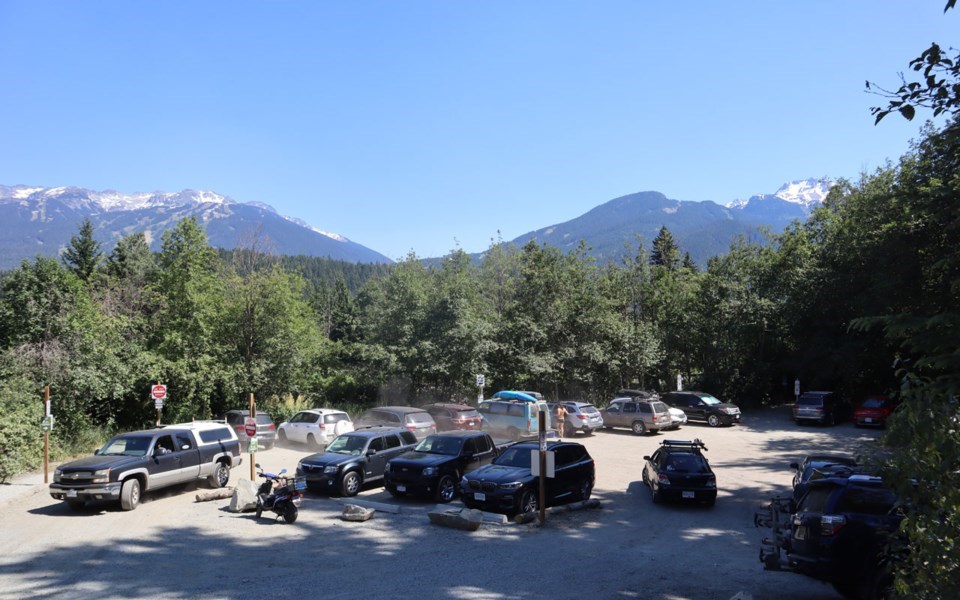The Resort Municipality of Whistler (RMOW) posted its strongest third-quarter in history for parking revenue last year, according to a quarterly report presented to local officials last week.
For the financial period ended Sept. 31, 2021, the municipality brought in $473,757 in parking revenue, compared to $361,996 for 2019’s third quarter. Since 2019, the RMOW has introduced hourly parking rates at electric-vehicle charging stations and increased parking rates at the day lots and at the conference centre and library. The municipality also introduced pay parking in local parks this summer, a move that, while largely unpopular with residents, has proven a valuable source of non-tax revenue for the municipality amidst the economic uncertainty of the pandemic.
“You’ll recall that parking as a non-tax revenue can be very effective in offsetting the required tax requisition,” explained the RMOW’s director of finance Carlee Price during the Jan. 11 council meeting. “Not a terribly beloved category … but they were very helpful to financial outcomes for the municipality and so can be considered good news for the third quarter.”
Municipal revenue through the first three quarters of 2021 was $83,601,191, approximately 90 per cent of budgeted amounts, while operating expenditures sat at $51,117,249, about 73 per cent of what was budgeted. That compares to 92 per cent and 71 per cent, respectively, for the same period in 2020.
The report highlighted “pockets of strong revenue” initially noted in the first half of the year persisting through the third quarter, largely driven by “a very vibrant real estate, construction, and renovation market,” which could be seen in revenues from permits ($4,142,476, which was 89 per cent of what was budgeted for the first three quarters) and works and services ($720,172, which was 38-per-cent more than expected).
Outside of the construction sector, the report noted that general economic activity in Whistler is “recovering from pandemic impacts less consistently.” The report pointed to Whistler’s Municipal and Regional District Tax (MRDT) revenue as a useful indicator of recovery being that it is closely linked to visitation. In 2021’s second-quarter report, MRDT revenue was noted as being down 79 per cent from 2019 levels, while in Q3 that improved to 24-per-cent below pre-pandemic revenues.
As parking revenues grew, transit fares continued to show “limited signs of recovery,” the report stated, with revenues down 48 per cent in the quarter compared to 2019. In December, an amendment was approved to draw on greater Transit Restart funding in order to help offset the discrepancy between actual revenues and the originally budgeted amounts.
The RMOW’s 2021 budget was amended three different times in part to manage finances throughout the ongoing pandemic.
“The 2021 operating revenues remain challenged by the COVID-19 environment,” said Price. “We do expect that the bumpy path on revenues will continue into the fourth quarter and of course 2022.”
On the expenditures side, municipal spending through the first nine months of 2021 was 73 per cent of budgeted levels. Project spending, which typically rises in the third quarter, totalled $23,043,931 through Sept. 30, representing 40 per cent of the budgeted amount. It’s worth noting that the totals only reflect project invoices that have been received and processed at the time.
“So the numbers contained in this report reflect expenditures and not necessarily the volume of work,” Price said. “It’s only at year-end that those two sort of come back into alignment.”
Price added that 101 of 154 planned projects reported some level of activity through the first three quarters of the year, with 31 hitting more than half of their planned spend by September.
The CAO office, which includes the RMOW’s communications and economic development departments, saw expenditures increase in 2021, totalling $2,154,616 for the first three quarters, 88 per cent of its budgeted amount. That compares to $1,798,085 for the same period in 2020.
“This is of course related to pandemic effects and helping to manage the community through those, as well as things like insurance, software maintenance expenditures and some other pandemic-related costs, including hosting a lot of council meetings outside of our normal areas due to capacity limits,” Price noted.
The RMOW had anticipated recovering this year almost half of the approximately $9.9 million in declined revenues compared to 2019, but with the transit budget amendment factored in, the municipality is looking at recovering about a third of that shortfall in fiscal 2021, “which leaves a little bit more progress to be made in 2022,” Price said.
“So fourth quarter is already looking a little bit mixed but the trend remains upward. The road ahead is not clear but certainly heading in the right direction.”





